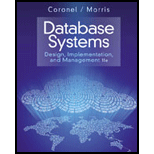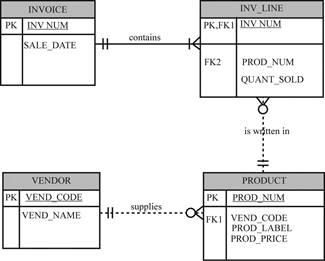
Concept explainers
a.
Normalization:
The process used to minimize data redundancy and dependency in a relational
Second normal form (2NF):
- The value of all non-primary key attributes should be dependent on the primary key attribute.
- If any attribute is depending on the partial primary key then it should determine the other attributes for an instance of the entity.
- The partial dependencies should be removed from the data model.
Third normal form (3NF):
- The value of any non-primary key attributes will not depend on any other non-primary key attributes.
- If any non-primary key attributes depend on any other non-primary key attribute then it should be moved or deleted.
- It is termed as transitive dependency.
Partial dependency:
A partial dependency exists at that time of an attributes depends only a part of primary key. This dependency is related with 1st normal form.
Transitive dependency:
A transitive dependency exists at that time of an attributes depends on another attribute which is not part of primary key.
Functional dependency:
An association between two attributes or two set of attributes in a same relational database table, which is having some constraints is known as functional dependency.
- In a table one attribute is functionally dependent on another attribute to take one value.
a.
Explanation of Solution
Construct the dependency diagram with all partial and transitive dependencies:
The relational schema for given INVOICE table is given below:
Invoice(INV_NUM, PROD_NUM, SALE_DATE, PROD_LABEL, VEND_CODE, VEND_NAME, QUANT_SOLD, PROD_PRICE)
- Here, “INV_NUM” and “PROD_NUM” indicates the primary key.
The representation of dependency diagram with all partial and transitive dependencies is shown below:

Explanation:
In the above dependency diagram,
- The partial dependencies are,
INV_NUM -> (SALE_DATE)
PROD_NUM -> (PROD_LABEL, VEND_CODE, VEND_NAME, PROD_PRICE)
- The transitive dependency is,
VEND_CODE -> (VEND_NAME)
b.
Normalization:
The process used to minimize data redundancy and dependency in a relational database is known as normalization. The database table is divided into two or more tables and defines the relationship between those tables.
Second normal form (2NF):
- The value of all non-primary key attributes should be dependent on the primary key attribute.
- If any attribute is depending on the partial primary key then it should determine the other attributes for an instance of the entity.
- The partial dependencies should be removed from the data model.
Third normal form (3NF):
- The value of any non-primary key attributes will not depend on any other non-primary key attributes.
- If any non-primary key attributes depend on any other non-primary key attribute then it should be moved or deleted.
- It is termed as transitive dependency.
Partial dependency:
A partial dependency exists at that time of an attributes depends only a part of primary key. This dependency is related with 1st normal form.
Transitive dependency:
A transitive dependency exists at that time of an attributes depends on another attribute which is not part of primary key.
Functional dependency:
An association between two attributes or two set of attributes in a same relational database table, which is having some constraints is known as functional dependency.
- In a table one attribute is functionally dependent on another attribute to take one value.
b.
Explanation of Solution
Construct the dependency diagram by removing all partial dependencies:
The new dependency diagram is represented by removing all partial dependencies in INVOICE table.
First table:
The relational schema for first table is given below:
3NF(INV_NUM, PROD_NUM, SALE_DATE, QUANT_SOLD)
- Here, “INV_NUM” and “PROD_NUM” indicates the primary keys.
- The relation is in third normal form (3NF), since there is no transitive dependency and no repeated attributes.
The representation of dependency diagram removes all partial dependencies in first table are shown below:

Second table:
The relational schema for second table is given below:
3NF(INV_NUM, SALE_DATE)
- Here, “INV_NUM” indicates the primary key.
- The relation is in third normal form (3NF), since there is no transitive dependency and no repeated attributes.
The representation of dependency diagram removes all partial dependencies in second table are shown below:

Third table:
The relational schema for third table is given below:
2NF(PROD_NUM, PROD_LABEL, VEND_CODE, VEND_NAME, PROD_PRICE)
- Here, “PROD_NUM” indicates the primary key.
- The relation is in third normal form (2NF), since there is transitive dependency in table.
The representation of dependency diagram removes all partial dependencies in third table are shown below:

c.
Normalization:
The process used to minimize data redundancy and dependency in a relational database is known as normalization. The database table is divided into two or more tables and defines the relationship between those tables.
Second normal form (2NF):
- The value of all non-primary key attributes should be dependent on the primary key attribute.
- If any attribute is depending on the partial primary key then it should determine the other attributes for an instance of the entity.
- The partial dependencies should be removed from the data model.
Third normal form (3NF):
- The value of any non-primary key attributes will not depend on any other non-primary key attributes.
- If any non-primary key attributes depend on any other non-primary key attribute then it should be moved or deleted.
- It is termed as transitive dependency.
Partial dependency:
A partial dependency exists at that time of an attributes depends only a part of primary key. This dependency is related with 1st normal form.
Transitive dependency:
A transitive dependency exists at that time of an attributes depends on another attribute which is not part of primary key.
Functional dependency:
An association between two attributes or two set of attributes in a same relational database table, which is having some constraints is known as functional dependency.
- In a table one attribute is functionally dependent on another attribute to take one value.
c.
Explanation of Solution
Construct the dependency diagram by removing all transitive dependencies:
The new dependency diagram is represented by removing all transitive dependencies in INVOICE table.
First table:
The relational schema for first table is given below:
3NF(INV_NUM, PROD_NUM, QUANT_SOLD)
- Here, “INV_NUM” and “PROD_NUM” indicates the primary keys.
- The relation is in third normal form (3NF), since there is no transitive dependency and no repeated attributes.
The representation of dependency diagram removes all partial dependencies in first table are shown below:

Second table:
The relational schema for second table is given below:
3NF(INV_NUM, SALE_DATE)
- Here, “INV_NUM” indicates the primary key.
- The relation is in third normal form (3NF), since there is no transitive dependency and no repeated attributes.
The representation of dependency diagram removes all transitive dependencies in second table are shown below:

Third table:
The relational schema for third table is given below:
3NF(VEND_CODE, VEND_NAME)
- Here, “VEND_CODE” indicates the primary key.
- The relation is in third normal form (3NF), since there is no transitive dependency and no repeated attributes.
The representation of dependency diagram removes all transitive dependencies in third table are shown below:

Fourth table:
The relational schema for final table is given below:
2NF(PROD_NUM, PROD_LABEL, VEND_CODE, PROD_PRICE)
- Here, “PROD_NUM” indicates the primary key.
- The relation is in third normal form (3NF), since there is no transitive dependency and no repeated attributes.
The representation of dependency diagram removes all transitive dependencies are shown below:

d.
Explanation of Solution
The representation of Crow’s Foot Entity Relational Diagram (ERD) is shown below:
The following data model shows the solution for the given question.

Explanation:
- In the above data model, one invoice can contains many invoice line.
- The “INVOICE” entity contains the “INV_NUM” and “SALE_DATE” attributes.
- The primary key of “INVOICE” entity is “INV_NUM”.
- The “INV_LINE” entity contains the “INV_NUM”, “PROD_NUM” and “QUANT_SOLD” attributes.
- The primary and foreign key of this entity is “INV_NUM”.
- The foreign key of this entity is “PROD_NUM”.
- The “INVOICE” entity contains the “INV_NUM” and “SALE_DATE” attributes.
- The product is written in more than one invoice line.
- The “PRODUCT” entity contains the “PROD_NUM”, “VEND_CODE”, “PROD_LABEL”, and “PROD_PRICE” attributes.
- The primary key of “PROD_NUM” for this entity.
- The foreign key of this entity is “VEND_CODE”.
- The “PRODUCT” entity contains the “PROD_NUM”, “VEND_CODE”, “PROD_LABEL”, and “PROD_PRICE” attributes.
- The vendor supplies more than one product.
- The “VENDOR” entity contains the “VEND_CODE” and “VEND_NAME” attributes.
- The primary key of “VEND_CODE” entity.
- The “VENDOR” entity contains the “VEND_CODE” and “VEND_NAME” attributes.
Want to see more full solutions like this?
Chapter 6 Solutions
Database Systems: Design, Implementation, & Management
- Show all the workarrow_forwardShow all the workarrow_forward[5 marks] Give a recursive definition for the language anb2n where n = 1, 2, 3, ... over the alphabet Ó={a, b}. 2) [12 marks] Consider the following languages over the alphabet ={a ,b}, (i) The language of all words that begin and end an a (ii) The language where every a in a word is immediately followed by at least one b. (a) Express each as a Regular Expression (b) Draw an FA for each language (c) For Language (i), draw a TG using at most 3 states (d) For Language (ii), construct a CFG.arrow_forward
- Question 1 Generate a random sample of standard lognormal data (rlnorm()) for sample size n = 100. Construct histogram estimates of density for this sample using Sturges’ Rule, Scott’s Normal Reference Rule, and the FD Rule. Question 2 Construct a frequency polygon density estimate for the sample in Question 1, using bin width determined by Sturges’ Rule.arrow_forwardGenerate a random sample of standard lognormal data (rlnorm()) for sample size n = 100. Construct histogram estimates of density for this sample using Sturges’ Rule, Scott’s Normal Reference Rule, and the FD Rule.arrow_forwardCan I get help with this case please, thank youarrow_forward
- I need help to solve the following, thank youarrow_forwardreminder it an exercice not a grading work GETTING STARTED Open the file SC_EX19_EOM2-1_FirstLastNamexlsx, available for download from the SAM website. Save the file as SC_EX19_EOM2-1_FirstLastNamexlsx by changing the “1” to a “2”. If you do not see the .xlsx file extension in the Save As dialog box, do not type it. The program will add the file extension for you automatically. With the file SC_EX19_EOM2-1_FirstLastNamexlsx still open, ensure that your first and last name is displayed in cell B6 of the Documentation sheet. If cell B6 does not display your name, delete the file and download a new copy from the SAM website. Brad Kauffman is the senior director of projects for Rivera Engineering in Miami, Florida. The company performs engineering projects for public utilities and energy companies. Brad has started to create an Excel workbook to track estimated and actual hours and billing amounts for each project. He asks you to format the workbook to make the…arrow_forwardNeed help completing this algorithm here in coding! 2arrow_forward
 Database Systems: Design, Implementation, & Manag...Computer ScienceISBN:9781305627482Author:Carlos Coronel, Steven MorrisPublisher:Cengage Learning
Database Systems: Design, Implementation, & Manag...Computer ScienceISBN:9781305627482Author:Carlos Coronel, Steven MorrisPublisher:Cengage Learning Database Systems: Design, Implementation, & Manag...Computer ScienceISBN:9781285196145Author:Steven, Steven Morris, Carlos Coronel, Carlos, Coronel, Carlos; Morris, Carlos Coronel and Steven Morris, Carlos Coronel; Steven Morris, Steven Morris; Carlos CoronelPublisher:Cengage Learning
Database Systems: Design, Implementation, & Manag...Computer ScienceISBN:9781285196145Author:Steven, Steven Morris, Carlos Coronel, Carlos, Coronel, Carlos; Morris, Carlos Coronel and Steven Morris, Carlos Coronel; Steven Morris, Steven Morris; Carlos CoronelPublisher:Cengage Learning A Guide to SQLComputer ScienceISBN:9781111527273Author:Philip J. PrattPublisher:Course Technology Ptr
A Guide to SQLComputer ScienceISBN:9781111527273Author:Philip J. PrattPublisher:Course Technology Ptr
 Principles of Information Systems (MindTap Course...Computer ScienceISBN:9781285867168Author:Ralph Stair, George ReynoldsPublisher:Cengage Learning
Principles of Information Systems (MindTap Course...Computer ScienceISBN:9781285867168Author:Ralph Stair, George ReynoldsPublisher:Cengage Learning





